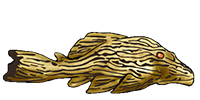| Scientific Name | Hoplisoma davidsandsi (Black, 1987) |
| Common Names | Sands' Cory Davids Pansermalle, Davids Pansermalle (Denmark), Panzerwels (Germany) |
| Type Locality | Rio Unini, whitewater area of the Rio Negro, Brazil. |
| Pronunciation | hop lee so mah - David SANDS eye |
| Etymology | Named for David Sands, the English aquarist behind the seminal 'catfishes of the world' books but who has not continued this output into the new millenium. |
| Size | 44mm or 1.7" SL. Find near, nearer or same sized spp. |
| Identification | C. davidsandsi is similar to C. melini both fish have a black stripe running from the lower dorsal fin to the lower caudal fin just past the caudal peduncle. In C. davidsandsi the line splits above the caudal peduncle (best viewed from above) and in most other species it does not split. Additionally, aside from the vertical eye stripe and the aforementioned back stripe, the flanks of C. davidsandsi are without further pigment, differentiating it from C. melini. |
| Sexing | Females are stouter, especially if viewed from above. |
| Distribution | South America: Negro River basin. Amazon, Middle Amazon (Solimoes), Negro (click on these areas to find other species found there) Login to view the map. |
| IUCN Red List Category | Not Evaluated |
| pH | 6.2 - 7.2 |
| Temperature | 20.0-25.0°C or 68-77°F (Show species within this range) |
| Other Parameters | A whitewater species that appreciates a little current. |
| Feeding | Flake food, tablets, frozen and live foods like worms etc. User data. |
| Furniture | Sandy bottom, wood and plants like java moss and java fern around the perimeter. |
| Compatibility | A perfect citizen. |
| Suggested Tankmates | Smaller South American characins, Apistogramma and other Corydoras. |
| Breeding | Like other Corydoras; water changes can induce spawning (T-clinch). Adding a small power filter or powerhead to the tank can help trigger spawning. Eggs are laid on the tank sides, on driftwood, and in plants. Eggs are prone to fungus. Suggest keeping the eggs in a floating net in the tank containing the parent fish. Alternatively, Methylene Blue can be used. Fry are fed with microworms after the yolk sac has been used up (3-4 days). |
| Breeding Reports | There are 3 breeding reports, read them all here. |
| Reference | Practical Fishkeeping 1987, pp 74, Fig. |
| Registered Keepers | There are 51 registered keepers, view all "my cats" data. |
| Wishlists | Love this species? Click the heart to add it to your wish list. There are 4 wishes to keep this species, see who wants what. |
| Spotters | Spotted this species somewhere? Click the binoculars! There are 14 records of this fish being seen, view them all. |
| Forum BBCode | |
| Search for H. davidsandsi | |
| Look up H. davidsandsi on AquaticRepublic.com | |
 | Look up H. davidsandsi on Fishbase |
 | Look up H. davidsandsi on Encyclopedia of Life |
 | Look up H. davidsandsi on Global Biodiversity Information Facility |
| LFS label creator ARN ref:1.1.1580.291 | |
| Last Update | 2025 Jan 02 01:38 (species record created: 2001 Apr 30 00:00) |





/siluriformes/callichthyidae/hoplisoma/davidsandsi/1.jpg)
/siluriformes/callichthyidae/hoplisoma/davidsandsi/2.jpg)
/siluriformes/callichthyidae/hoplisoma/davidsandsi/3.jpg)
/siluriformes/callichthyidae/hoplisoma/davidsandsi/4.jpg)
/siluriformes/callichthyidae/hoplisoma/davidsandsi/5.jpg)
/siluriformes/callichthyidae/hoplisoma/davidsandsi/6.jpg)
/siluriformes/callichthyidae/hoplisoma/davidsandsi/7.jpg)
/siluriformes/callichthyidae/hoplisoma/davidsandsi/8.jpg)
/siluriformes/callichthyidae/hoplisoma/davidsandsi/9.jpg)
/siluriformes/callichthyidae/hoplisoma/davidsandsi/10.jpg)
/siluriformes/callichthyidae/hoplisoma/davidsandsi/11.jpg)
/siluriformes/callichthyidae/hoplisoma/davidsandsi/12.jpg)